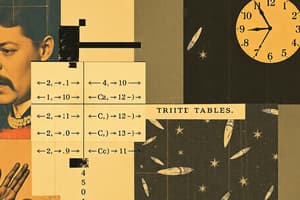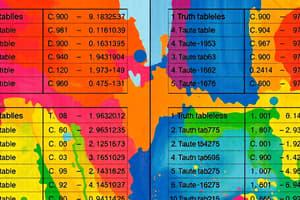Podcast
Questions and Answers
ଯେକଣ, ମୋଟ ମାନିଆଯିବା ସଠୀର ସୂଚୀ 'P → Q' କେତେ ସଠୀର ସୂଚୀ ରୁପରେ ମୋଟ ମିଳେ?
ଯେକଣ, ମୋଟ ମାନିଆଯିବା ସଠୀର ସୂଚୀ 'P → Q' କେତେ ସଠୀର ସୂଚୀ ରୁପରେ ମୋଟ ମିଳେ?
- 4 (correct)
- 2
- 1
- 3
P ଓ Q ସୂଚୀ ସධ ସධ ସධ
P ଓ Q ସୂଚୀ ସධ ସධ ସධ
- F, T
- F, F
- T, F
- T, T (correct)
P → Q ୟ rj qk pswikr tswikr eni pswikr qkent ink pswikr eni pswikr qkenf in rj qk~ pswikr tswikr e
P → Q ୟ rj qk pswikr tswikr eni pswikr qkent ink pswikr eni pswikr qkenf in rj qk~ pswikr tswikr e
- Q
- ~Q (correct)
- F
- T
P ସwswikr enj k swikswiki?
P ସwswikr enj k swikswiki?
P → Q ସwswikr enj k swikswiki?
P → Q ସwswikr enj k swikswiki?
Truth Table-ର P → Q ସwswikr enj k swikswiki?
Truth Table-ର P → Q ସwswikr enj k swikswiki?
ପ୍ରମାଣାର୍ଥିକ ମେଳା କିଏ ସୃଷ୍ଟି କରୁଥି?
ପ୍ରମାଣାର୍ଥିକ ମେଳା କିଏ ସୃଷ୍ଟି କରୁଥି?
De Morgan's ଗୁସ୍ତି ସୃଷ୍ଟି ସহ ସীমিত ସ্থিতি ସহ ସহায়ক।
De Morgan's ଗୁସ୍ତି ସୃଷ୍ଟି ସহ ସীমিত ସ্থিতি ସহ ସহায়ক।
Negation (!) ସ� ସ� ᔊ� � � � ᔊ� ?
Negation (!) ସ� ସ� ᔊ� � � � ᔊ� ?
Propositional Logic ସ� � � � � ?
Propositional Logic ସ� � � � � ?
Propositional Logic-� ������� ���������� ����������� ������������ ������������ ������������ ������������������ ������������.
Propositional Logic-� ������� ���������� ����������� ������������ ������������ ������������ ������������������ ������������.
!False =?
!False =?
Flashcards are hidden until you start studying
Study Notes
Exploring Logical Foundations with Propositional Logic
Logic is a discipline concerned with reasoning and making deductions based on statements called propositions. These propositions can be either true or false, giving rise to two fundamental building blocks of logical systems—truth values. When we couple these truth values with rules of inference and connectives like 'and,' 'or,' and 'not,' we enter the realm of Propositional Logic.
In this introductory exploration into Propositional Logic, let's dive deeper into some essential concepts and applications.
Truth Tables and Formulas
To evaluate whether a given proposition is true or false under certain conditions, logicians construct Truth Tables where each possible combination of truth values for multiple propositions determines one overall conclusion. For instance, consider the simple implication P → Q, meaning if P is true, then Q must also be true; otherwise, the statement is considered false. A truth table representing all four combinations shows clearly how the compound proposition behaves:
| P | Q | P → Q |
|---|---|---|
| T | T | T |
| T | F | F |
| F | T | T |
| F | F | T |
The column labeled "P → Q" represents our implication formula evaluated according to its truth table definition. This format provides a convenient tool for examining more complicated formulations containing several interconnected propositions.
Connectives
Connectives allow us to combine individual propositions within compounds in various ways, providing specific relationships between them. Some elementary examples include:
- Conjunction (∧): A conjunction joins two propositions with the symbol "&," indicating both parts must be true for the entire expression to be considered true.
- Disjunction (∨): In contrast, disjunctions join propositions using "|," revealing that any single one of the combined propositions needs to be true for the entire expression to be regarded true.
- Negation (!): Negating a proposition reverses its truth value by prefixing it with an exclamation point ("!"), turning a True statement False, and vice versa.
These three basic forms represent significant components of Propositional Logic. Other connectives exist and derive from these initial ones through De Morgan's laws, which are useful tools for simplifying expressions involving negated connectives.
Contemporary Applications
While Propositional Logic has deep roots in philosophical debate, its application ranges far beyond abstract contemplation. Today, this field finds widespread usage in many domains, including computer science, mathematics, artificial intelligence, engineering, and linguistics. Examples include parsing natural languages, checking patterns in data analysis, program verification, software design, and automated theorem proving in mathematical proof development.
Mastery over Propositional Logic enables us to understand complex arguments, reason systematically, and draw well-founded conclusions. As such, exploring this branch of formal logic provides readers with valuable skills for critical thinking and problem-solving across diverse fields of endeavor.
Studying That Suits You
Use AI to generate personalized quizzes and flashcards to suit your learning preferences.




